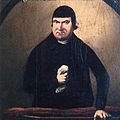| Providence Chapel | |
|---|---|
 The former chapel from the south | |
 | |
| 50°59′45″N0°10′54″E / 50.9958°N 0.1816°E | |
| Location | Main Road, Hadlow Down, East Sussex TN22 4HJ |
| Country | England |
| Denomination | Independent Calvinistic |
| History | |
| Status | Former chapel |
| Founded | 1824 |
| Founder(s) | Henry Smith |
| Architecture | |
| Functional status | Residential conversion |
| Heritage designation | Grade II |
| Designated | 31 December 1982 |
| Style | Classical |
| Completed | 1849 |
| Closed | 1993 |
Providence Chapel is a former independent Calvinistic place of worship in the village of Hadlow Down in Wealden, one of six local government districts in the English county of East Sussex. Although built in 1849, the chapel can trace its origins to the founding in 1824 of an Independent place of worship in the village (pre-dating the local Anglican church by 12 years). The new building was in religious use for nearly 150 years, but storm damage led to its closure and conversion into a private dwelling in 1993—although its former graveyard survives. The chapel is a Grade II Listed building.


